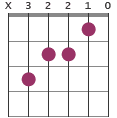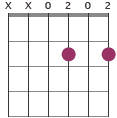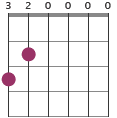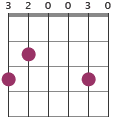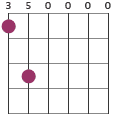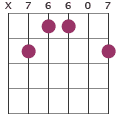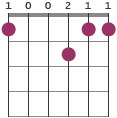6th chords
The 6th chord is a four-note chord that adds the sixth degree note in the scale to the major triad. By comparing C with C6 we could see that the notes changes from C, E, G to C, E, G, A.
6th chords in open positions
C6
D6
E6
F6
G6
A6
B6
Comments
These are, generally, chords in open position, with F6 as an exception which is a closed chord (with no loose strings).
Noticeable is that B6 is played with an alternative bass note (F#), see different versions below.
The first chord diagram from the left is a popular way to play C6. It's easy to memorize since it has almost the same positions as C major. But it doesn't include a fifth (G). It's not strictly necessary to include the fifth, but alternative versions that do so are presented below.
Also noticeable is that F6 doesn't have a third (C). The presented version above is popular to play, but an alternative is mentioned below.
6th chords with flats and sharps
Since these are not played all that often, they are only presented in shortened notation:
C sharp / D flat 6th: X4332X
D sharp / E flat 6th: X6554X
F sharp / G flat 6th: XX4342
G sharp / A flat 6th: XX6564
A sharp / B flat 6th: X13333
Theory
The major 6th chord can be found on the IV and V degrees in a major scale. In C major, this would be F6 and G6.
Chord formula
The sixth is built with the formula 1-3-5-6 (root, major 3rd, perfect 5th and major 6th).
Chord construction
C6 E - A - E - G - C - GD6 x - x - D - A - B - F#
E6 E - B - E - G# - C# - E
F6 x - x - F - A - D - F
G6 G - B - D - G - B - E
A6 x - A - E - A - C# - F#
B6 F# - B - D# - G# - B - x
Guitar versions of the chord
Notes in chord
C6 C - E - G - AC#6 C# - F - G# - A#
D6 D - F# - A - B
D#6 D# - G - A# - C
E6 E - G#- B - C#
F6 F - A - C - D
F#6 F# - A# - C #- D#
G6 G - B - D - E
G#6 G# - C - D# - F
A6 A - C# - E - F#
A#6 A# - D - F - G
B6 B - D# - F# - G#
The intervals are 1 – 3 – 5 – 6
Other versions
G6
G6
C6/E
C6/G
E6
F6
B6
Comments
The first C6 chord diagram is played with alternative bass note (E). It's possible to play without the 6th string also, making it a C6/A to be strict. The second diagram shows how C6 can be played by bar four strings on the fifth fret. The E6 can also be played with an open low E-string. This particular chord shape could be combined with a major 7th chord version with similar shapes. For example, Bb6/F (XX3333) and Bbmaj7 (XX3335).
The third diagram present a way to play F6 in open position and include all four tones belonging to it. However, it somewhat harder to play than the version presented above and not especially popular.
The diagram to the right presents a second way to play B6, this time with the root note on the bass string (5th string). It somewhat trickier than the open chord variation.
Simplified versions in jazz context
Two shapes with bass notes on 6th and 5th strings could be added, which are espicially common in jazz:
C6: X322XX
C6: 7X79XX
Movable 6th chord
Here are two ways to play the 6th with movable shapes, including a barre shape.
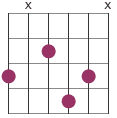
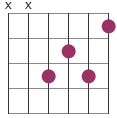

The root note is the same as the bass note in all examples.
6th chord in open position
Here are additional shapes in open position for this chord category:
F6: 10021X
G6: XX5430 / 350000
G6/A: X05700
G6/D: X55430
G#6/D#: XX1111
Bb6: X1303X
6th chord inversions
A 6th chord is possible to play in numerous configurations including three inversions (it's also common to combine inversions with omitting notes for this chord type).
C6 can be used as an example:
- C - E - G - A (root position)
- E - G - A - C (1st inversion)
- G - A - C - E (2nd inversion)
- A - C - E - G (3rd inversion)
To indicate that a chord is played inverted it is written as slash sign before the bass note. For example, the first inversion of the C6 chord is written C6/E. Some examples follow below in short notation:
C6/E: 002013
C6/G: 302010
C6/A: X02013
D6/E: 000202
D6/F#: 200202
D6/B: X20202
E6/F#: 2042100
E6/A: X09999
E6/B: X22120
F6/A: X033231
F6/C: X10211
F6/C: X30231
G6/A: X00000
G6/B: X20030
G6/D: XX0000
A6/C#: X44220
A6/E: 007675
B6/D#: XX1102
B6/E: 021102
B6/F#: 22110X
For more chord diagrams, see The Chord Reference ebook.
Chord progressions
Progressions including this chord type:
C - C6 - F - F6
C6 - G11 - Dm7
A6 - B9 - Emaj7
C6 - C#dim7 - Dm7 - G11
G6 - Dmaj9/F# (200220) - Em6
The 6th chord work as I, IV and V chords. So, for example, in C major key, C6, F6 and G6 are viable (diatonic) options.
A certain way to use the 6th chord is together with a major triad and
a major seventh with the same root, which creates a descending movement in the middle voice:
C - Cma7 - C6
D - Dmaj7 - D6
G - Gmaj7 - G6
To create a similar middle voice line, but with an ascending movement, an aug chord can be included:
D - Daug - D6 - D7
